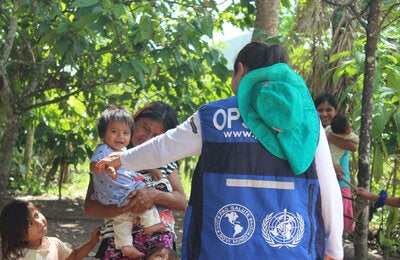
Some 44% of deaths in the Americas are caused by diseases linked to unhealthy diets
Washington DC, December 9, 2020 (PAHO) – Stark front-of-package warnings against foods excessive in fats, sugars, and sodium are the best way to help people avoid the unhealthiest purchases, a new PAHO report shows.
PAHO reviewed six different categories of front-of-package food labeling systems to determine which perform best to help consumers correctly, quickly and easily identify products that are excessive in nutrients associated with the top three causes of death in the Americas – overweight/obesity, diabetes, and cardiovascular diseases.
The front-of-package warning labels work better than other kinds of nutritional labeling such as healthy food endorsements. (To see the other nutritional labeling systems, go to page 8 in Front-of-package labeling as a policy tool for the prevention of noncommunicable diseases in the Americas.)
“Overweight and obesity rates have exploded in the Americas,” said PAHO Director Carissa F. Etienne. “The front of package warning labels can guide healthier choices, save lives, improve the quality of life in the Region, and protect our human rights and those of our children. This is an urgent public health situation and we simply cannot wait.”
Some 44% of deaths in the Americas are caused by high blood pressure, high sugar levels, and obesity and overweight. Poor diets are driven largely by the widespread availability and marketing of processed and ultra-processed food and drink products that are excessive in sugars, fats and sodium.
“Front-of-label warnings protect the rights of consumers to have truthful, extensive, simple, easily understood information about what the products are and what they contain,” said Ernesto Acevedo, Deputy Secretary of Industry, Commerce, and Competitiveness for Mexico. He said Mexico adopted the labeling because of epidemic obesity that has affected health, the economy, and social and economic inequity.
Earlier this year, Mexico implemented the black octagonal warning labels that follow PAHO’s best practices recommendations, including the PAHO nutrient profile, a tool to classify food and drink products that are in excess of free sugars, salt, total fat, saturated fat and trans-fatty acids. The country subsequently was recognized by the United Nations Interagency Task Force on the Prevention and Control of Noncommunicable Diseases.
In previous years, Chile, Peru, and Uruguay adopted front-of-package warnings, and Brazil has taken a step in that direction. In Canada and Colombia, warnings have been proposed for mandatory use.
The Caribbean is in the final stages of adopting warnings as part of regional standards, while Argentina is in the process of adopting comprehensive, robust legislation, which requires products to display warning labels, prevents such products from being advertised and bans them from schools.
In the Mexican regulation and in those under discussion in Argentina and the Caribbean, the PAHO nutrient profile criteria is being used to determine which products should have a warning. This allow consumers’ purchase decisions to align with WHO recommendations.
“The majority of populations in our Region and worldwide still lack access to simple information about whether a product is excessive in sugars, sodium, saturated fats, trans fats or total fats,” said Anselm Hennis, Director of the Department of Noncommunicable Diseases and Mental Health at PAHO. “The solution is a clear, quick and easy warning label on the front of the package providing understandable information.”
He added that such labeling is even more important now, as underlying conditions linked to poor diet can lead to life-threatening complications from COVID-19.
Media Contacts
Sebastian Oliel
Daniel Epstein
Nancy Nusser
mediateam@paho.org



